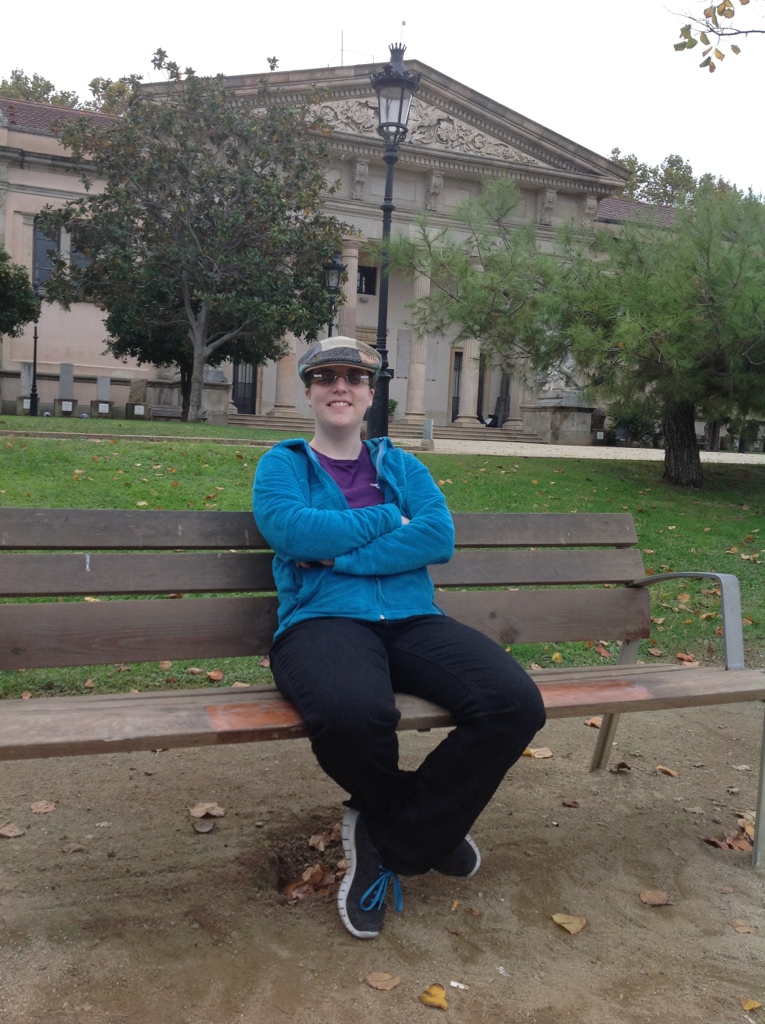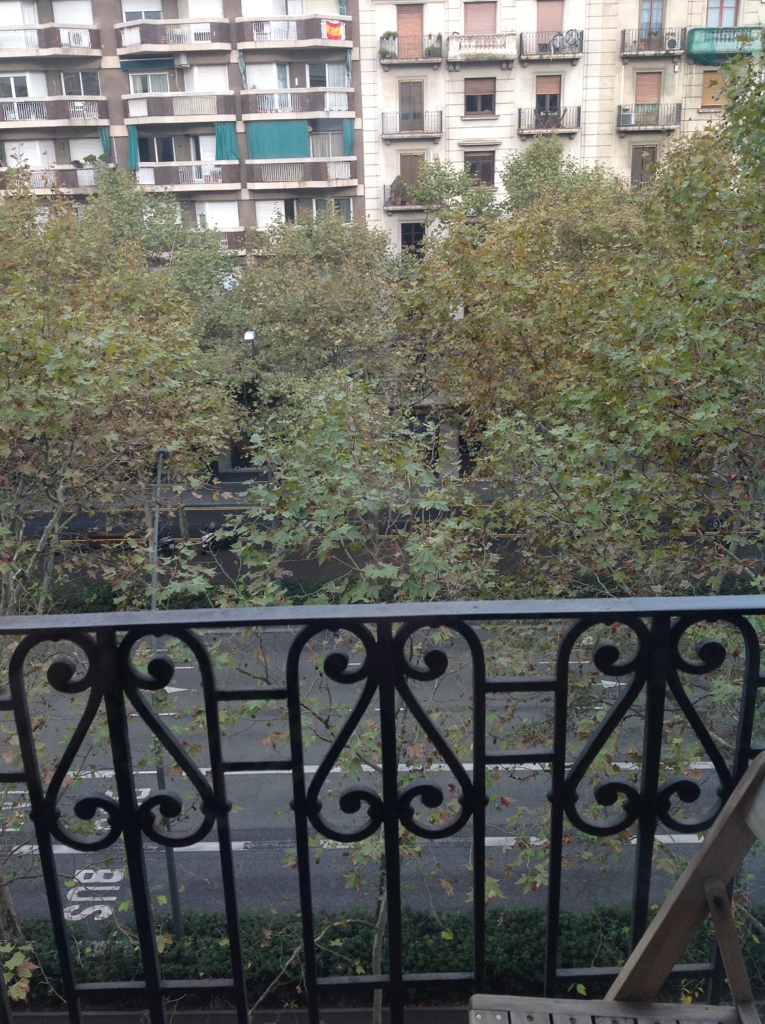
Barcelona has free wifi in some public spaces. We have wandered into a big park en route to the Picasso Museum via tapas. This is a pretty cool town.
Parva Leves Capiunt Animos

Barcelona has free wifi in some public spaces. We have wandered into a big park en route to the Picasso Museum via tapas. This is a pretty cool town.
Right now it is close to sunset at the end of our first full day in Barcelona. I’m lying on the couch of the charmingly twee Casa de Billy, while the roar of traffic comes up from the Gran Via. It has a more elaborate name, but all the signs just say Gran Via, one of several wide boulevards cutting pencil-scratch straight across the whole city. We are two blocks from Plaça Espanya, and about 10 blocks from Las Ramblas.
Today was about walking, and to a lesser extent about food. Since it is the Done Thing, we strolled up to Plaça Catalunya and then down to Las Ramblas and thence down to the marina. Which was on the whole underwhelming. It’s a nice enough boulevard, but purely lined with all the “hey, this is where the tourists come” shops. It’s there, we’ve done it, but a definite “meh”. On the other hand, the adjacent Barri Gòtic was great. It’s the oldest part of town, a medieval maze of tiny streets and alleys, with the cathedral and several churches tucked in, punctuated by gorgeous Plaça. We started from the port end, and everything was closed up – it appears to be wall-to-wall clubs and bars that only open at night. A little further on from there we passed into the hipster zone, and then further into a patch of nice boutiques and small galleries.
Near the cathedral was an art market, and in one of the loveliest squares – Plaça de Sant Felip Neri – was Museu Del Calçat. Which is the guild hall and museum for the shoemakers guild, apparently being on this site since the Middle Ages, and manned by an attendant from the Confraria de Sant Marc Evangelista who had also been there since 1202. For €5 it’s a great little museum.
Lunch was tapas, of course, at La Alcoba Azul, tucked away near Plaça Sant Jaume. Awesome food, cool and dark, with a great relaxing (and hippy) vibe.
Some things we noticed today:
1) There are a lot of dogs about (although not in the bars and shops like in London), of a startling variety of breeds and sizes. We’ve seen three cats. One fat and possibly feral strolling the boulevard. One going for a walk on a leash in Barri Gòtic. And one peering down from a third floor window box.
2) there is some sort of election or referendum campaign in progress, with some theme around Catalonian independence, and there are Catalan flags everywhere. I would not be surprised if the province split from Spain qua Spain.
3) we bought a Spanish phrase book, and some language guides. Which turn out to be distinctly Castillian. Which is slightly problematic as the region is Bilingual, with Catalan quite different to Castillian, and the Castillian spoken here with a different accent.
4) there are a lot of vacant offices and shop fronts, a stark indication of how deep in the poo the economy is here
5) while the roads a busy, and full of taxis, there are a lot of mopeds, scooters and small motor bikes around. There are also a lot of cyclists, but I suspect that’s because we are in the tourist area more or less – I must have seen a dozen different bike hire places in the small area we traversed, including some nifty electric bikes. Fortunately not the Segways we saw American tourists getting around on though.
Right now we shall have a late Siesta, then head out in search of more food. Touch wood better than what we found last night, chosen randomly and found to be pretty ordinary. I doubt I will be disappointed. Tomorrow, probably the Picasso museum.

The view from our window at Casa de Billy
We are off again! I could grow to like this traveling stuff. But airport food…


I did say that I would try to write something each Tuesday after training at what is now The Sword, London, so here we go.
More work on stepping and footwork last night, and it feels like it is starting to come together, although I must say it only feels natural to me with a sword in hand.
More relevantly I sparred briefly with TinyTim last night, the first free sparring in almost a year, and with long sword to boot. To my surprise I didn’t suck as much as I expected. Which isn’t to say I was not soundly trounced and now have some embarrassing bruises, and am so out of shape it felt like a marathon. But I did start to relax and get the flow back, and toward the end was not letting him get away with the easy shots and delivered some satisfying strikes.
Apart from the obvious – being out of shape and still coming to grips with long sword – I noticed that I am suffering from two problems to resolve:
1. I have been conditioned to telegraph hits and to strike outside the body
2. I am forgetting to keep mobile and maintain distance.
More sparring please. Bruises are a sword’s way of telling me I was in the wrong place at the wrong time.

I popped back to the Wallace to have another look at the plates from Thibault that Dave R was demonstrating here. (and just spent 10 minutes explaining it all to an American actor)
They key point of the plates for me is that Thibault’s turn is very much on the spot, but crucially is only done when Alexander’s body is well past Zacahry’s point: he turns inside the blade. It’s a very restrained and careful action (apart from the context of ramming the rapier through someone up to the hilt) and there is no opening for Zachary to exploit.

We are about to go on a tour of the Noble Art of The Sword at the Wallace Collection with Toby Capwell the curator, followed by dinner. Let me just say we like the Wallace greatly.
I decided last night as I took the train home from training (the training train?) that one way to help cement each evenings training would be to write about it. Simply recounting what we did will be of limited use, so rather I need to consider how I reacted to the training each evening.
We focused again on the cuts along the diagonals, given that they are simple and natural but also because they lead into many areas of investigation. The true-edge cuts went smoothly, with just a bit of adjustment to my footwork. To echo Meyer’s body shape, I have to extend my body more forward over my left foot, and reach for that almost-but-not-quite falling forward feel. My previous training wants me to put all my weight on the left leg, but I need to keep some of it on my right too so that I can push forward with my right as I take a big step forward. Thats something new I learned: the forward motion is a step and not a jump.
One thing I am still not doing with the cutting drill is getting the cuts coming through the face: the centre of the cross is still somewhere down around my chest height. When I do focus on getting the pattern shifted up higher, the line of the cuts suffers and the edge wobbles all over the place. I suspect when I return to doing them with dussack that will improve though: I feel like I am muscling the long sword around as though it was heavy, rather than just relaxing and letting it flow.
We started on the false edge cuts, which initially felt weird until I stopped thinking about them and just restricted myself to thinking: my sword is here, and I want it to go along that next diagonal to wind up with the false edge at the other end of the diagonal. My body knows how to do that, I just have to turn off my mind so that it doesn’t get in the body’s way. Any philosopher who wants to argue against Descartesian dualism should be required to wave a sword around.
The reworking of the mechanics of the big step made the zornhau drills work better: in general I found that if I relaxed, got the sword moving ahead of me so that I had to follow it, and bought my hands through the line to cut through rather than striking the target, then I was arriving where I needed to. What I learned: “covering the line” in my head maps onto “keep the sword between me and his sword”.
I still have to work on the Big Step: I think that I am trying to cushion my landing by touching my foot down with the front of the foot, rather than just stepping out as though walking. This is pulling me up short. Thinking is in progress.
Yes yet another “hey I just found this out, so you need to know it too”. And by the way, if you do find this useful, I would really like you to comment on this post so that other people will find it too.
I need to set up Jetty 8 to use a JTA provider. Quick googling around suggested that I need to take into account the following:
The kicker being of course that those documentation resources are out of date. Pause here for a quick rant: please, so that you do not go to a special hell reserved for people who cause huge numbers of lives to be wasted, if you are releasing code and documentation into the wild: update the frakking documentation!. Sadly, most google searches for anything about Jetty go to those elderly Codehaus pages, rather than the more up-to-date but obscure pages at http://wiki.eclipse.org/Jetty
In order to get the combination of Jetty 8.x and Atomikos 3.8.x and JNDI working, you need to look in the right place, and put the right class path in your Jetty JNDI definition:
<New id="tx" class="org.eclipse.jetty.plus.jndi.Transaction">
<Arg>
<New class="com.atomikos.icatch.jta.UserTransactionImp"/>
</Arg>
</New>
and to copy the following from the Atomikos lib/ directory into the Jetty lib/ext/ directory:
geronimo-j2ee-connector_1.5_spec.jar
geronimo-jms_1.1_spec.jar
geronimo-jta_1.0.1B_spec.jar
and finally to copy all the JARs from the Atomikos dist/ directory into the Jetty lib/ext/ directory.
Note that I have not yet tested this exhaustively, and suspect that not all of these JARs are needed.
So one of the things that showed up in the bundle of mail I received on the weekend was the annual statement from my Superannuation fund. In Australia there is a compulsory scheme, where part of your salary is stuffed into a super fund, locked away until you retire (or die). This has made a lot of people very angry, and a very small number of people very wealthy, and is probably indirectly responsible for the obscenely high rents in most of the major cities.
Then there’s the insult on top of the injury: my money that they claim to be carefully invested lost somewhere over $8,000 in the year. And they charged me a bit over $1,000 to carefully manage my funds backwards. Any other business would be out of business if they tried that, but the Super funds are hallowed, sacrosanct and politically immune.
Let’s just say that I intend for the fund managers to be first up against the wall when the revolution comes.